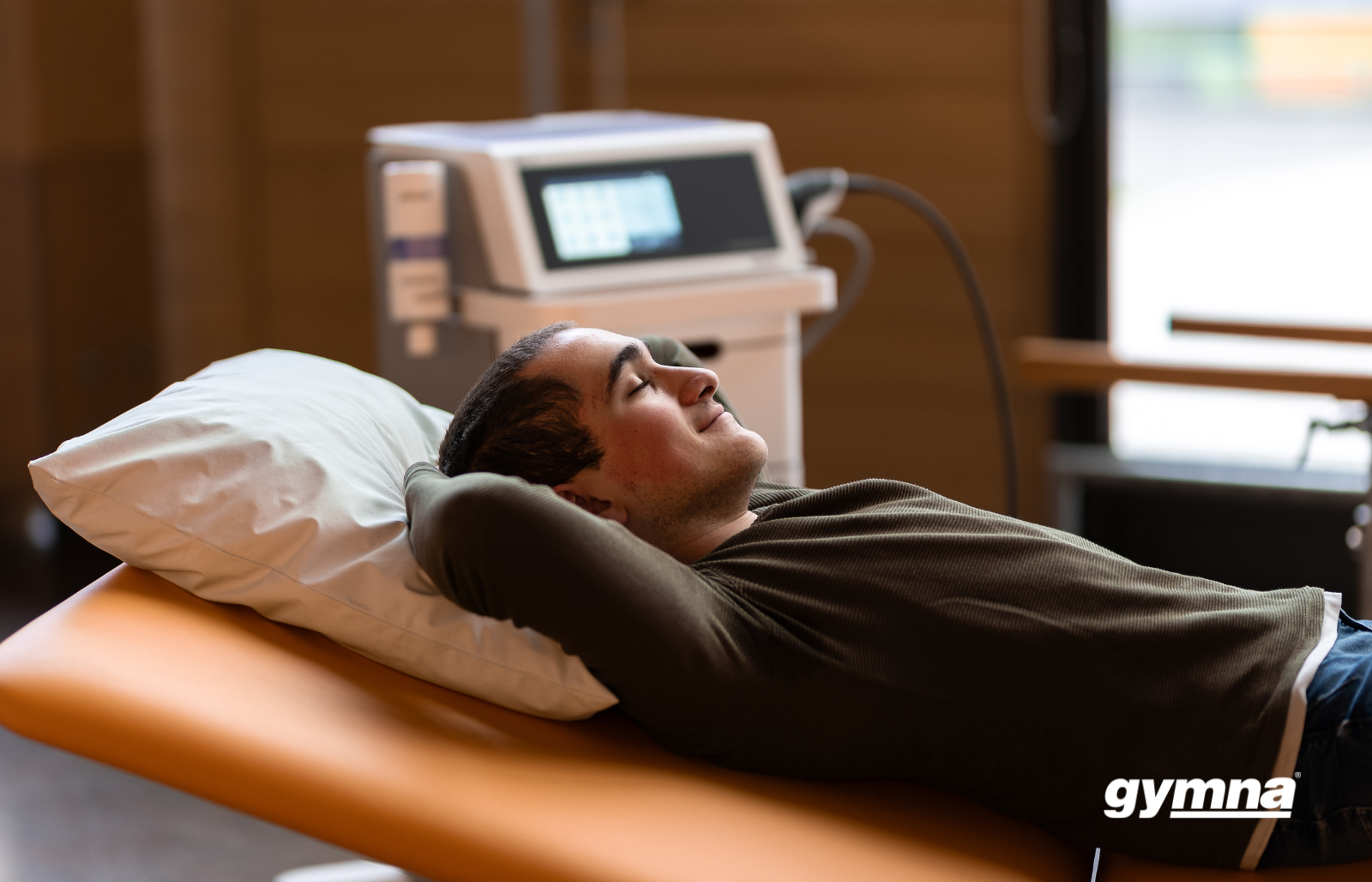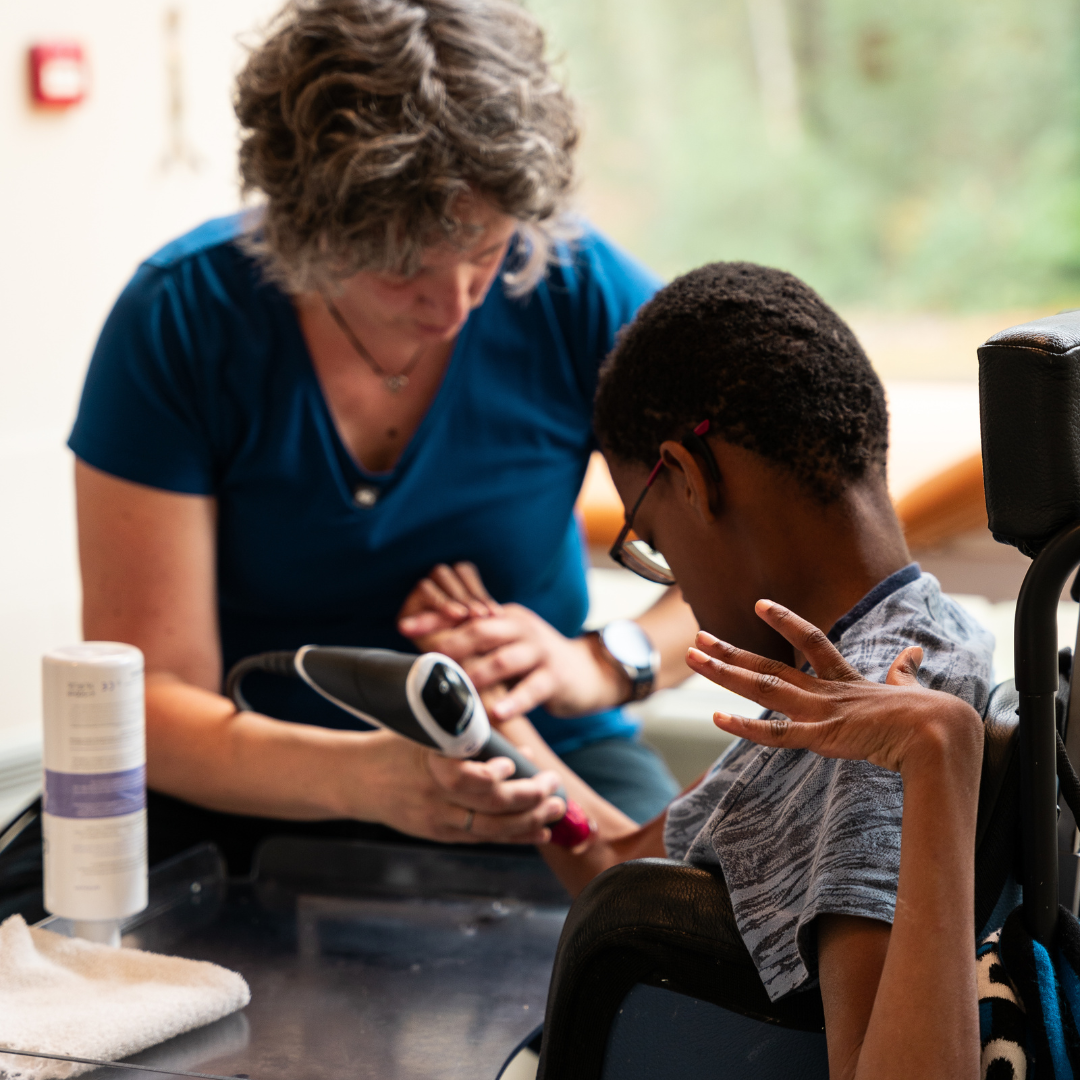Shockwave therapy in the treatment of spasticity in children
Initial insights from a pilot effectiveness study

Shockwave therapy is rapidly gaining ground in the world of physiotherapy. It has demonstrated its effectiveness as a treatment method for chronic pain and tendonitis, but it is also increasingly being used to treat other syndromes, such as spasticity. So far, scientific literature has been mainly focused on the application of shockwave in adults with spasticity, but what about children suffering from the same conditions?
To answer this question, Gymna and Sint-Gerardus in Diepenbeek (a Belgian centre of expertise offering specialised care, therapy and education for children and young people with (neuro)motor disabilities, all on one campus) joined forces and are conducting a pilot study on the effect of radial shockwave therapy in children with spasticity. Physiotherapist Tamara shares her personal motivation and first experiences with this promising treatment method.
What is spasticity?
In spasticity, the muscles of the limbs in question contract intermittently or permanently. As a result, muscle tension in the affected limb increases and mobility decreases. Spasticity can occur when there’s brain damage, or damage to the spinal cord, such as in the case of a CVA, cerebral palsy and MS. Spasticity can be painful, but it can also restrict a patient’s movements, making ADL difficult.
[1]There are multiple treatment options available for spasticity, such as orally administered medication, physiotherapy, botulinum toxin injections, an intrathecal baclofen pump, selective dorsal rhizotomy and shockwave therapy. In this article, we’ll focus solely on shockwave therapy.
Shockwave for spasticity
Extracorporeal shockwave therapy (ESWT) is a non-invasive treatment method in which short, intense sound waves activate the body's own repair processes.[2] It is a promising treatment technique for spasticity as it breaks the link between actin and myosin, thereby reducing stiffness in connective tissue.
Advantages of ESWT:
- Effectively reduces spasticity
- Safe
- Painless
- Non-invasive
- No side effects
- Cost-saving
- Easy to integrate into physiotherapy treatment
Shockwave for spasticity in children in the literature
[1]In their systematic review of treatments for children with spasticity, Kudva et al (2021) compare a more invasive baclofen pump, a selective dorsal rhizotomy and shockwave therapy. All methods lead to significant improvements, but the practical and financial advantages in contrast to the other two methods favour non-invasive ESWT.
[2]In their systematic review, Otero-Luis et al (2024) investigate the effectiveness of ESWT on reducing spasticity in the upper extremities of children with cerebral palsy. They found that shockwave therapy is most effective just after its application and that the obtained effect can last up to 3 months.
[1,2]Thus, although existing studies show promising results, more research with larger study groups is needed to better substantiate the effectiveness, optimal frequency and application sites of shockwave therapy.
That is precisely what the ongoing pilot study at Gymna and St Gerardus is currently investigating. Physiotherapist Tamara, one of the executive therapists involved in the study, encounters the limitations of invasive techniques and the side effects of drug treatments on a daily basis. That is why she was so eager to actively participate in the search for innovative treatments to help the children she works with move forward as well as to relieve them of the burden of major interventions.
Looking for the right treatment
The pilot study was of course preceded by a thorough two-year preparation period involving multiple parties. More than 20 children aged between 6 and 18 years were selected to participate in the study. In October 2024, Tamara was finally able to start the first of two intervention periods. For four weeks, she and her colleague treated half of the participants weekly with radial shockwave therapy, and that for a total of four times. Three months later a follow-up occurred. During the second intervention period in February 2025, the other half of the participants were treated. Official results will follow after the summer.
About Tamara
Tamara graduated as a physiotherapist in 2002 and has been working at Sint-Gerardus, a multifunctional centre for children and adolescents aged 0 to 21 with neuromotor disabilities, ever since. She mainly deals with post-operative physiotherapy, for example after Botox injections or following a surgical treatment.
Tamara's motivation
Tamara is extremely motivated to participate in this study: "There is an increasing demand for evidence-based forms of therapy. Innovation and collaboration play a major role in this search and I am happy to play my part in that process. But even better is the fact that I myself am actively involved in this study. Studies at the universities of Leuven or Hasselt usually do not involve the physiotherapists from Sint-Gerardus. In this study, I have been able to think and decide for myself from the very start and was able to play a completely different role in the implementation of this study ."

Research challenges
Despite the long and extensive preparation, the treating therapists ran into several challenges. Tamara: "It proved difficult to maintain one single protocol, because of the large interindividual differences between the children. Every child involved is different, both physically and mentally."
Incidentally, the mental capacity of some children posed a challenge in itself : "Shockwave therapy involves lots of loud noises. How can you explain to the youngest children or children with a mental disability that the noise they hear at the first treatment does not signal possible pain? That explanation and the entailing slow start-up therefore take up extra time and energy.
Finally, there was the time commitment, which was estimated to be too limited. Tamara: "Normally, a treatment with shockwave takes a maximum of 15 minutes, but for the purpose of the study we have to perform measurements before and after the treatment. And for standardisation purposes, we also remove the splints, which, if you count everything up, make the treatments take a bit longer."
Fortunately, the challenges mentioned above have been overcome and the children are very enthusiastic. They are happy to go through this journey with their trusted therapists. Tamara: "Some children even described that their treatment felt like a massage. How nice is that?"
Counselling during treatment with pGTS
The study was conducted using the Gymna ShockMaster, equipped with its unique Patient Guided Therapy System (pGTS). The pGTS has a user-friendly interface and includes evidence-based treatment protocols. In the preliminary phase of the study, Tamara used the therapy system to develop her own skills and experience with the shockwave device. She did so by treating colleagues with complaints, such as Achilles tendon pain.
Tamara: "The pGTS makes the start-up easier, as you know which values you need to work towards. Depending on your patient, the settings are also easy to adjust. With some protocols you can start directly with the suggested values, while other protocols require you to set the intensity a bit lower at first. The fact that images are used to indicate which areas to treat with which head makes treating patients even easier. For this study, a special program was created to read the data per participant anonymously."
Tamara's experiences and mid-term insights
As the study is still ongoing, no statements can yet be made about any possible significant improvements nor about the effect of shockwave on spasticity in children. Nevertheless, Tamara is happy to share her own first experiences as a study participant and an external physiotherapist.
Measuring instruments
Tamara: "We use three measurement tools to evaluate the treatment. The Modified Ashworth Scale (MAS), the Range Of Motion (ROM) and the Patient Specific Functional Scale (PSFS).
With the MAS, we objectify the degree of spasticity. In these values, I expect little progression, as most children already score a 1 or 1+ at the baseline.
Regarding ROM, I do expect to see an improvement in the treated regions, as I’m already seeing clear differences in both the pre- and post-measurements. The question is, of course, to what extent this improvement will hold up over time. I have no insight into this aspect myself, as the official measurements are done by other therapists.
Functionally, the treatments are already making a big difference for at least one participant. One of our patients, a 16-year-old girl, could often not sleep due to cramps before starting the study. After being treated, she slept much better and hardly woke up at all."
A nice unexpected phone call
And Tamara shares another great experience with us: "Many children are treated outside Sint-Gerardus by other physiotherapists. These physiotherapists do not know when their patient is being treated at Sint-Gerardus and which muscle groups are being addressed during said treatments. One of these outside physiotherapists called us at the end of the first intervention. He indicated that he did not know if his patient had already been treated, but that he noticed a decrease in tension in certain limbs. His patient had indeed been treated during the first intervention period, and the limbs in question were in fact the ones treated by us. A wonderful phone call to receive."
Official survey results
Although official results are not due until after the summer break, so far everything is looking promising. Non-invasive shockwave therapy seems easy to integrate into existing treatments, has no serious side effects and offers a nice alternative to the frequently used and invasive Botox injections that can even be harmful when used excessively.1 All signs point to shockwave being a potential gamechanger. We will publish the results on our website in due course, so stay tuned.
Discover shockwave therapy from Gymna
Shockwave therapy is already being used for many clinical pictures, and soon it may be possible to add another clinical picture to the list. Does the versatility of shockwave therapy appeal to you? Then find out more about shockwave therapy and the advantages of Gymna's evidence-based ShockMaster here.
[1] Kudva, A., Abraham, M. E., Gold, J., Patel, N. A., Gendreau, J. L., Herschman, Y., & Mammis, A. (2021). Intrathecal baclofen, selective dorsal rhizotomy, and extracorporeal shockwave therapy for the treatment of spasticity in cerebral palsy: a systematic review. Neurosurgical Review, 44(6), 3209-3228. https://doi.org/10.1007/s10143-021-01550-0
[2] Otero-Luis, I., Cavero-Redondo, I., Álvarez-Bueno, C., Martinez-Rodrigo, A., Pascual-Morena, C., Moreno-Herráiz, N., & Saz-Lara, A. (2024). Effectiveness of Extracorporeal Shock Wave Therapy in Treatment of Spasticity of Different Aetiologies: A Systematic Review and Meta-Analysis. Journal of clinical medicine, 13(5), 1323. https://doi.org/10.3390/jcm13051323
